What a content designer can do that ChatGPT can't
Page last updated: 12 May 2024
Contents
Is ChatGPT coming for your job?
When ChatGPT launched, we wondered if it could mimic the art of content design. Could it replicate the voice of the writer and the empathetic qualities that are intrinsically human? The answer is: ‘no’ and ‘not any time soon’.
Now that the hype has settled on OpenAI’s ChatGPT, we can take a step back to assess the limitations of artificial intelligence (AI). We can see more clearly that the skills honed by a content designer are irreplaceable.
Here are some examples of what a content designer can do that ChatGPT can’t.
A rich and unending source of inspiration
ChatGPT relies on pre-existing data and patterns to find the answers to your questions. It has the whole internet at its artificial fingertips. But that’s where it stops. It can’t go beyond the web and step into a person’s shoes.
Where content designers draw inspiration from
Because of our lived experience, we can attach more meaning and depth to statistics and figures. The insights we extract from data are enriched by our connection to people. It’s this connection that enables us to improve the overall user experience in a way that ChatGPT never could.
You can ask a machine to enhance a piece of content, and it will provide grammar and punctuation corrections. It will even restructure information and distil content so it’s easier to read.
Personal experiences.
Physical and live interactions.
Emotions.
Cultural nuances.
Context.
What ChatGPT cannot do
A content designer’s personal touch adds an authentic tone to their work. They can easily tap into their source of inspiration, product and business goals. Their approach is more in-depth, comprehensive and considered, going beyond the reach of the machine.
Change the language to suit the specific regional or cultural nuances of your audience.
Access and consider the words you’ve used consistently throughout the product lifecycle.
Conduct interviews with your users to test how they perceive your content.
Understanding context

A brief overview of ChatGPT
ChatGPT operates within the parameters of learned patterns, making it susceptible to generating content that may lack sensitivity or cultural awareness.
It can also source and serve up incorrect and fabricated information. A content designer can check the accuracy, legitimacy, validity and truth.
It can also source and serve up incorrect and fabricated information. A content designer can check the accuracy, legitimacy, validity and truth.

The skills of human writers
Human writers possess the innate ability to navigate the subtleties of language, adapting their tone, style, and content to suit the unique demands of a given context. This adaptability is crucial in crafting content that is not only grammatically correct but also socially and culturally relevant.
Trends and cultural norms can flip on a dime, and humans are much more agile when it comes to change. They can pivot instantly without waiting for reprogramming or code changes to feed the update.
By being aware of context, content designers create empathy for their audience. They always think of and advocate for the user. They put themselves in the shoes of their users and take the time to understand their ever-changing perspectives and needs.
Knowing your audience takes time. ChatGPT is all about speed, spewing information out within seconds. Human connection and context are where it falls short. Ultimately, it fails to provide and consider a complete picture of the user.
Emotional intelligence
Emotional intelligence is a facet of human writing that sets it apart from the capabilities of AI. While ChatGPT can recognise and produce responses based on emotional cues, it lacks emotional depth.
Human emotions are complex, layered, and often contradictory; content designers can convey these nuances through words. The definition of content design is the intentional use of words to help people complete a task or solve a problem.
A content designer will carefully consider the words they choose to align content to a user’s:
-
emotions
-
experience
-
expectations
-
understanding.
Intuition and creativity
The role of intuition in the creative process cannot be overstated. Content designers possess a unique intuition that guides them in making creative choices. They experiment with language and take risks that may not conform to established patterns — the patterns that govern AI.
Through the design process, content designers apply various techniques to create delightful user experiences. They use ‘blue sky thinking’, user story mapping and interviews. These techniques think outside the box, consider the user journey and speak directly with users.
Working without limitations (divergence) and then coming together to work within boundaries (convergence) is all part of the creative process. This approach is not wired into ChatGPT.
"Applying intuition and creativity establishes content design as a form of artistry."
- Content Design Hub
How content designers can use ChatGPT
While ChatGPT has its limitations, there are still ways it can be embraced and used as a writing aid. The word ‘aid’ is key.
1. Idea generation
Have you ever encountered the ‘blank page’ problem? ChatGPT can be a valuable tool for brainstorming and generating new ideas. Writers can prompt the model with a topic or theme, and ChatGPT can offer content examples to help content designers break through creative blocks.
With idea generation, you need to have a solid starting point. It doesn't need to be perfect, just write down your first thought.
With idea generation, you need to have a solid starting point. It doesn't need to be perfect, just write down your first thought.
Content that ChatGPT can generate includes:
-
blog post ideas
-
article drafts
-
research overviews
-
content summaries
-
keyword lists.
ChatGPT prompt one: start broad
Use AI as a starting point.
Enter a broad prompt like 'Give research examples of why complex words are hard to read.'
ChatGPT can give you a list of related sources. However, it's still important to fact check them to ensure they're accurate and relevant.
Enter a broad prompt like 'Give research examples of why complex words are hard to read.'
ChatGPT can give you a list of related sources. However, it's still important to fact check them to ensure they're accurate and relevant.
Broad prompt example
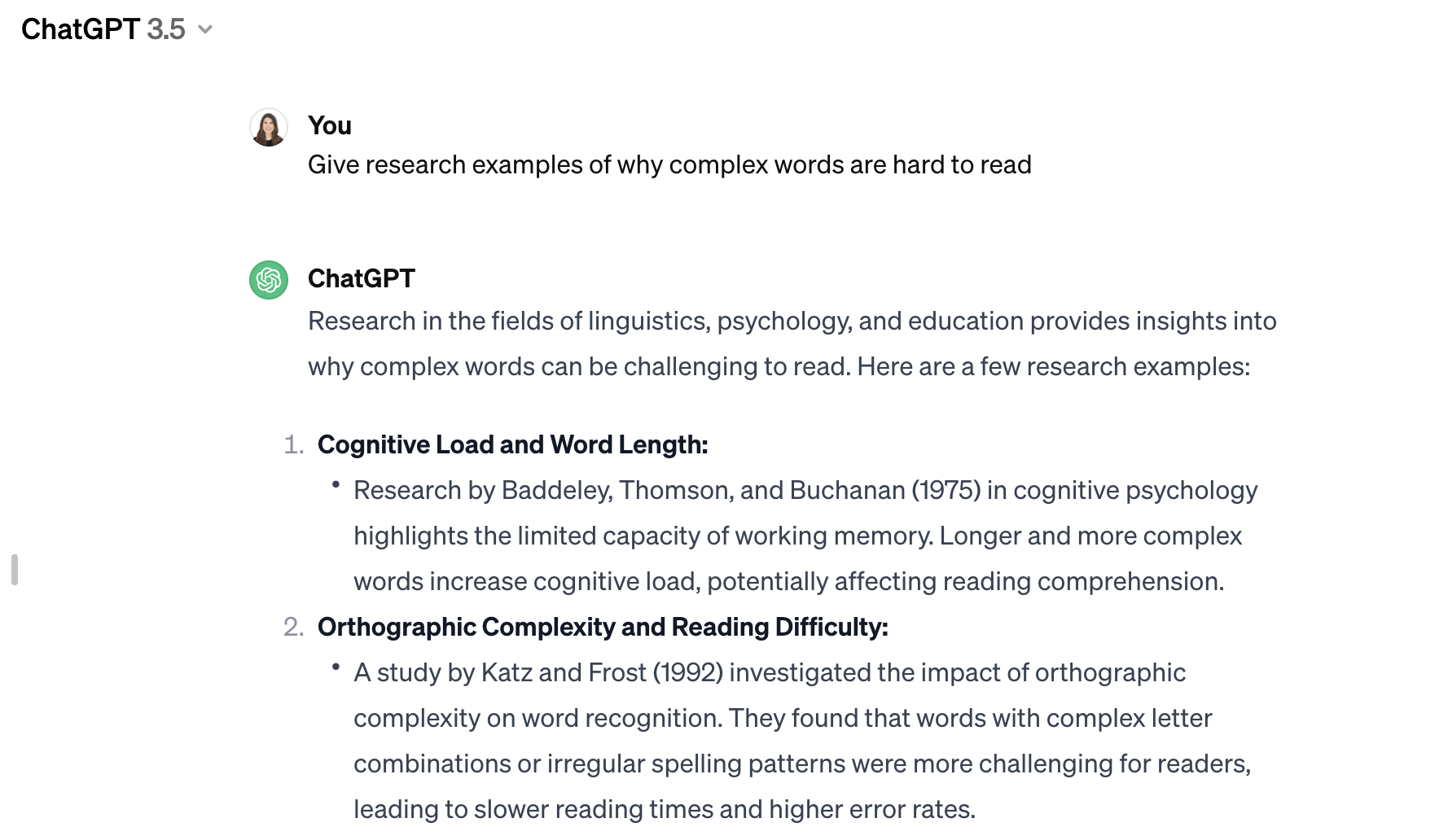
ChatGPT prompt 2: dive deeper
Ask more queries that expand upon your topic.
For example, 'Provide a summary of why complex words are hard to read'.
With this query, ChatGPT can list a number of barriers readers face when given complex words. This is where you can start a journey of diving deeper into insights.
The more you refine and specify your questions, the better the output of ChatGPT.
For example, 'Provide a summary of why complex words are hard to read'.
With this query, ChatGPT can list a number of barriers readers face when given complex words. This is where you can start a journey of diving deeper into insights.
The more you refine and specify your questions, the better the output of ChatGPT.
Refined prompt example
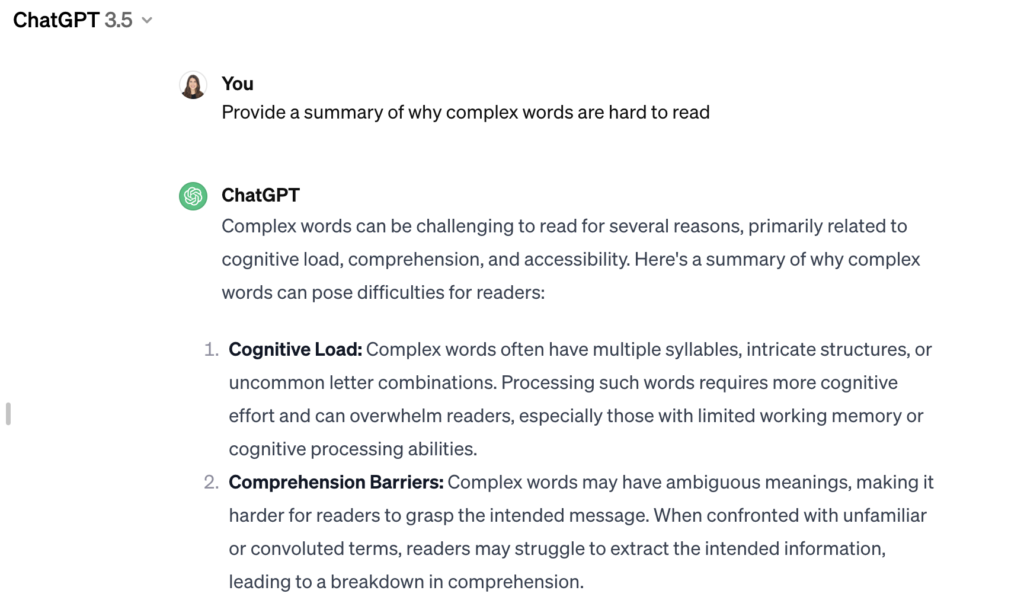
2. Desktop research
ChatGPT can be used to gather information on a topic quickly. It can clarify research on various subjects. Content designers can use it to replace Google Search, asking it to provide insights on specific areas of interest.
In ChatGPT, particular questions are helpful to explore research. However, it does have its limitations. For example, at the time of this article, ChatGPT was asked to ‘Give a summary of the latest updates to WCAG’ but only provided updates before 2022. It could not access the latest data for 2024.
On topics like accessibility, being up to date is critical. Lagging 2 years behind spreads misinformation and inaccuracies.
The limits of ChatGPT
When expertise is still needed
I asked ChatGPT to 'Give a summary of the latest updates to WCAG.'
Here's a summary of its response: 'My last knowledge update was in January 2022 and the guidelines may have been updated.'
It's clear that we still need the expert eye of the content designer to make sense of information. We must analyse ChatGPT's responses for relevance and factual correctness.
Over time, ChatGPT’s access to data will improve. But until then, asking for deep and specific research insights may prove challenging.
Here's a summary of its response: 'My last knowledge update was in January 2022 and the guidelines may have been updated.'
It's clear that we still need the expert eye of the content designer to make sense of information. We must analyse ChatGPT's responses for relevance and factual correctness.
Over time, ChatGPT’s access to data will improve. But until then, asking for deep and specific research insights may prove challenging.
Example of ChatGPT lacking data
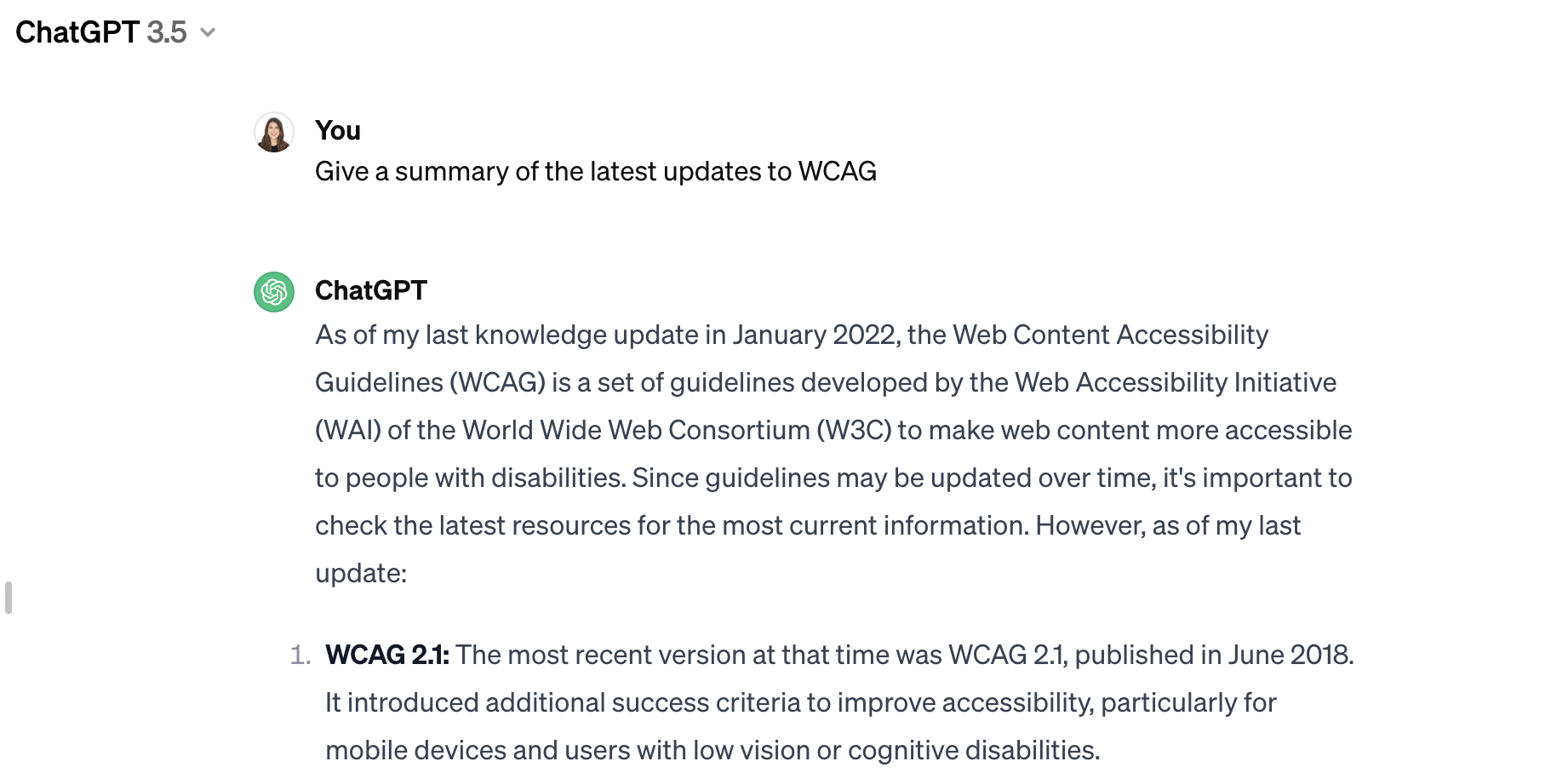
3. Reviews and edits
ChatGPT can assist in the editing process and act as a peer reviewer. Content designers can use it as a virtual writing assistant to enhance the overall quality of their work.
Watch out for the different English spellings. ChatGPT defaults to American English.
Watch out for the different English spellings. ChatGPT defaults to American English.
Edits ChatGPT can provide include:
-
grammar and punctuation
-
spelling
-
sentence structure
-
tone of voice
-
word choice.
Prompt to review grammar
I asked ChatGPT to review text for grammatical corrections.
I deliberately added text with mistakes to understand what ChatGPT can do.
I received a response that had fixed all the grammatical errors. However, be cautious that some choices like the 'Oxford comma' might not align with your content style guide.
To improve ChatGPT's accuracy, consider giving it your content style guide and asking it to give recommendations that align with your guidance material.
I deliberately added text with mistakes to understand what ChatGPT can do.
I received a response that had fixed all the grammatical errors. However, be cautious that some choices like the 'Oxford comma' might not align with your content style guide.
To improve ChatGPT's accuracy, consider giving it your content style guide and asking it to give recommendations that align with your guidance material.
Example of grammar prompt
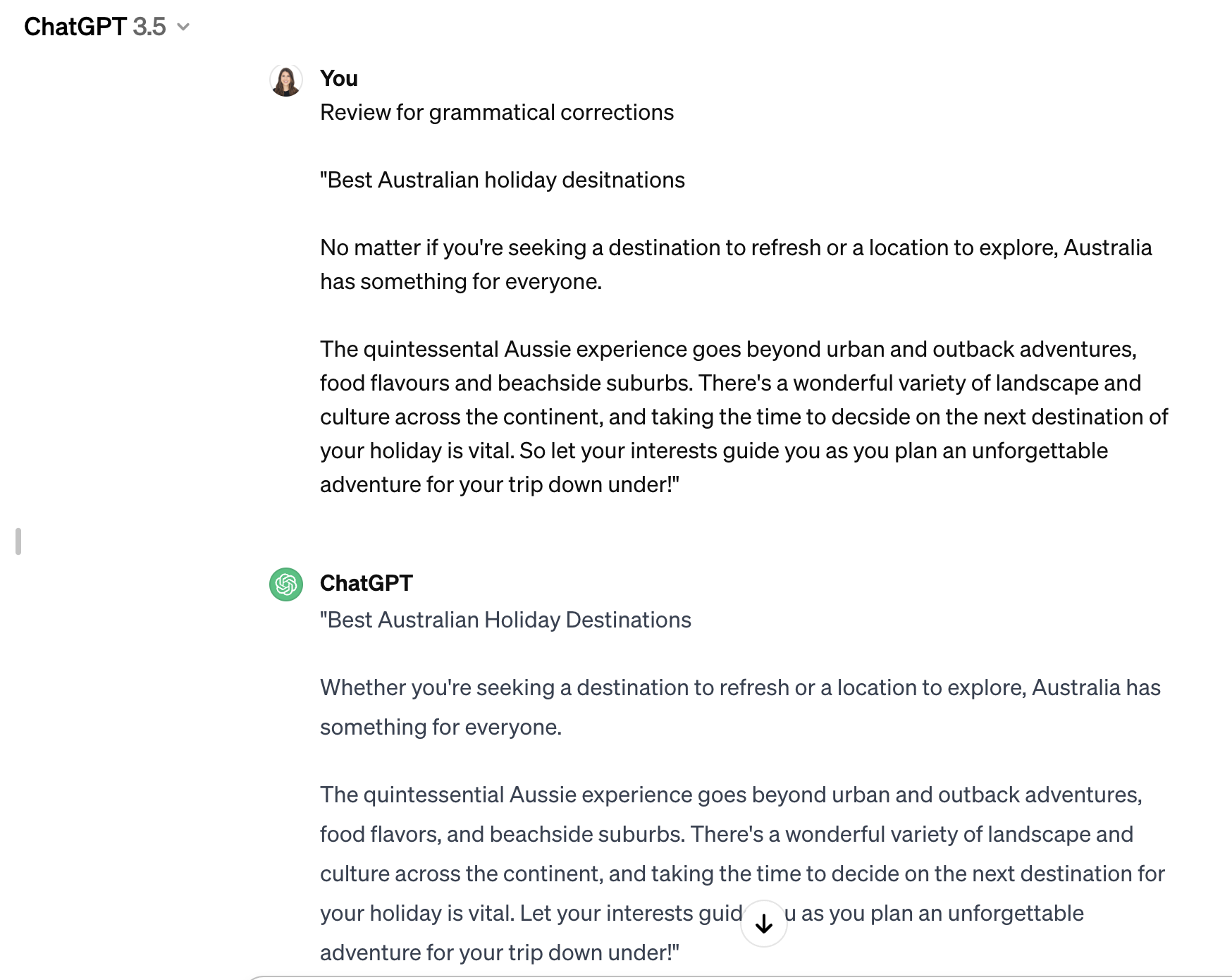
Prompt to review tone and voice
I gave ChatGPT existing content and asked it to apply an 'Australian tone of voice.'
The response was very Australian.
Here, it's the content designers role to either pair back the tone or give it more flair.
The response was very Australian.
Here, it's the content designers role to either pair back the tone or give it more flair.
Example of tone and voice prompt
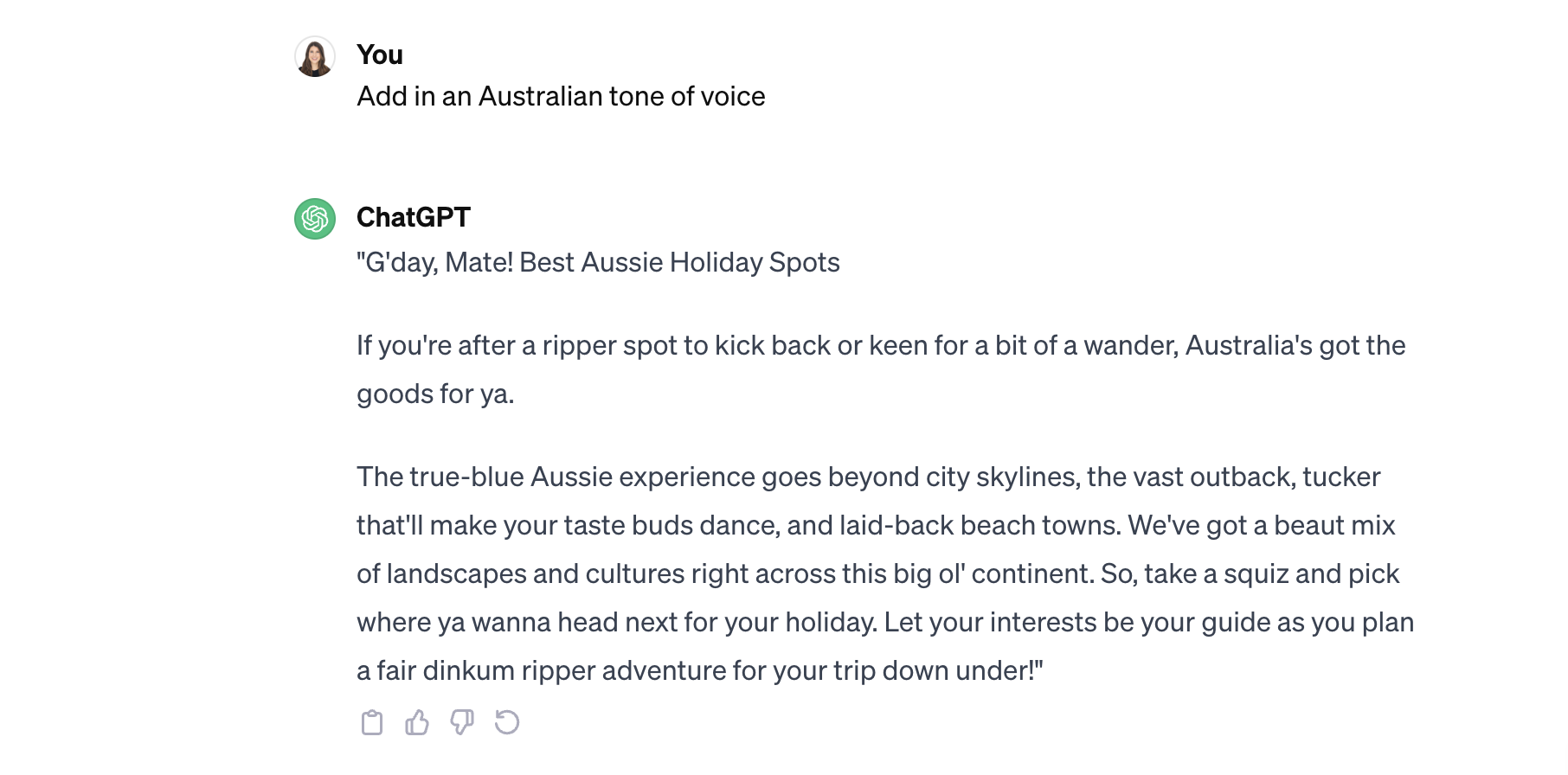
Prompt to apply plain English to text
I asked ChatGPT to re-write some existing text in plain English.
To take ChatGPT's response further, I recommend adding this information into a readability tool.
A readability tool like Hemingway or ProWritingAid will give you even more suggestions on how to simplify your content.
To take ChatGPT's response further, I recommend adding this information into a readability tool.
A readability tool like Hemingway or ProWritingAid will give you even more suggestions on how to simplify your content.
Example of readability prompt
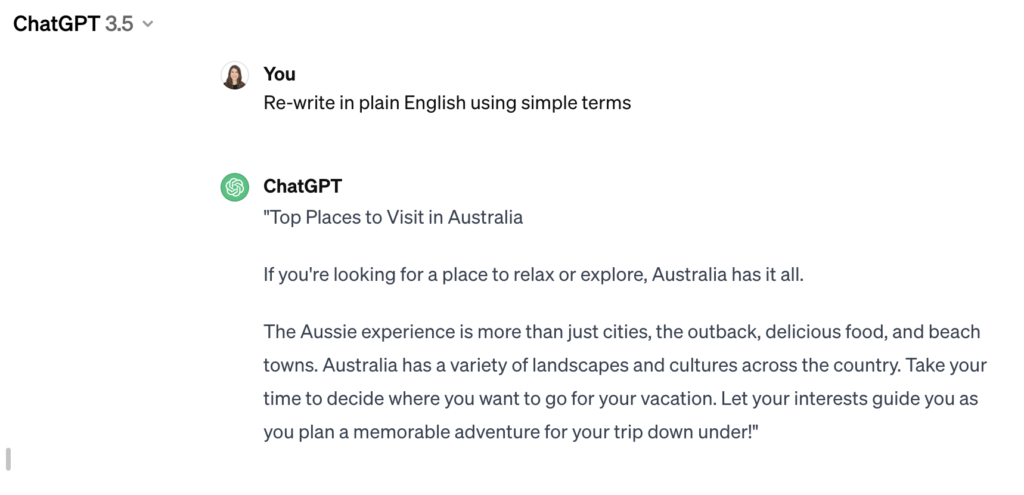
Protect your information
Beware of the type of information you feed ChatGPT. The content you give it is used to improve its language model. Your conversations, queries and personal details are stored in the system. This includes your email address, device, IP address and location. We recommend not giving ChatGPT any sensitive, protected or proprietary information.
The skills of content designers are irreplaceable
Technology has enhanced and improved the work of writers. With the emergence of AI writing aids like Grammarly, we sped up the peer review process. At times, we even eliminated it. So why should ChatGPT be viewed any differently than a helping artificial hand?
ChatGPT can undoubtedly generate text based on patterns learned from vast data. It can access large amounts of data that no human ever could. Yet, it still can’t replicate the unique touch of a content designer. That special touch is personal, emotional and contextual to the human experience.
We are yet to develop robots and IA that are sentient beings. So, a world where content designers are replaced is still far off. We suggest everyone can use the OpenAI model as an aid rather than a replacement for the content designer.

Author bio
Liz Leigh is the Co-Founder of Content Design Hub. She advocates for all things content design, helping individuals and companies to create accessible content.
Upskilling
Get free content coaching
Want to enhance the qualities that make you human? Add to your skill repertoire with our 1:1 content design coaching.


Content Design Hub is a marketplace for individuals and companies to learn, upskill and invest in specialised content skills.
We're grateful to the Traditional Owners of the lands throughout Australia on which we live, learn and work. We pay our respects to their Elders, past, present and emerging.
Policy pages
Social media
Copyright © Content Design Hub 2025. All rights reserved.

